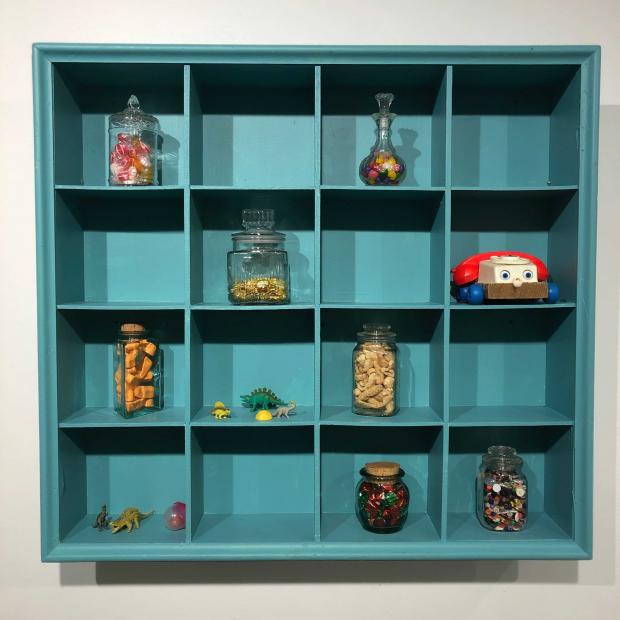Obsidian Bellis: Apothecary for Sis
In a series of carefully constructed tableaux, Obsidian Bellis quietly explores questions of identity, gender, and race, and how one might reconcile legacies of familial and generational history with a contemporary world marked by the overabundance of images.
A teal blue mini shelving unit, with a four by four grid of cubby holes, welcomes the visitor to the exhibition, titled Apothecary by Sis. Containing found objects ranging from jars of candy to toys, Treasures for Young Hearts invites the viewer to imagine the individual conjured up by the various assortment of trinkets. A jar of pennies, another full of mismatched buttons, little plastic dinosaurs, peppermint candies—Bellis describes the figure of your favorite grandparent or elderly relative, with all the knick knacks she might have in wait to entertain a young child.
Treasures for Young Hearts sets up the conceit that runs through the exhibition: Bellis organizes objects, found or made, in tiny collections, each framed by a physical support—be it a shelf, a curio cabinet, or other structuring principle—to evoke a figure through the composition of these signs. In the vein of installation art, Bellis requires the viewer to activate the work phenomenologically. It is an interactive experience that offers the viewer-participant jars, containing herbs or powders or manufactured items, to unscrew and sniff, little boxes to open up, objects to handle and gauge the weight of the memory and emotion contained within.
In Treasures for Young Hearts, as in some of the other pieces, a number of the spaces on the shelves or in the cabinets are empty, leaving the viewer to freedom to populate the spaces with items from their own lived experiences and memories, or perhaps to signal that the artist’s memory of this individual is incomplete, as memories are wont to be.
Obsidian Bellis, Detail from In My Bag (2019).
Bellis’ playfulness leads the viewer through the exhibition. With Laughing Mink, which features a head of a black doll, decorated and adorned, and encased in a glass jar, they ensure that you question whether or not the figures you’ve just called up are racialized. Laughing Mink stares back at the viewer, untouchable, its laugh trapped in its glass encasement. And if there was any doubt about your place in the system of contemporary image and material culture the exhibit is part of, Nesting, with its mirrored backing confronts you, the viewer, with your own image, framed by an assortment of objects, including keys, animal skin, and tiny birdcage—a constellation suggestive of colonialist underpinnings.
If the exhibition hinges on the construction of imagined personalities, Nite Cap returns us to Treasures for Young Hearts and grounds the exhibition in the very real presence of Bellis’ grandmother, whose youthful, smiling face looks out at the viewer from within a small picture frame. Nite Cap alerts the viewer to the subtle conversation in the exhibition between Bellis and her grandmother, between the weight of genealogy and the artists’ hopes and dreams for their future. We might read that struggle in the title, Apothecary for Sis, where “apothecary” is suggestive of the arrangement of the work, more notably the herbs, powders, dried natural matter, as though each installation serves as a medicinal solution to an undefined ailment. But “apothecary” also indicates the subject responsible for that concoction, and Bellis as healer thus also offering up a vision of salving oneself from the baggage of history, be that personal or generational.
With In My Bag, Bellis literalizes their journey, arranging suitcases, items of clothing haphazardly strewn over them, and an open briefcase, sparsely filled with slips of paper, receipts, envelopes, and crystals. While In My Bag serves to insert the artists’ presence into the exhibition, perhaps almost too forcefully, this piece feels superfluous and at odds with the tender carefulness present throughout. Containment need not equal constrictment, and Bellis’ gentle packaging of objects projects more a sense of protectiveness than a distancing from the world.
Apothecary for Sis is on view at Buffalo Arts Studio through May 3, 2019.

